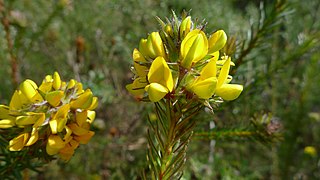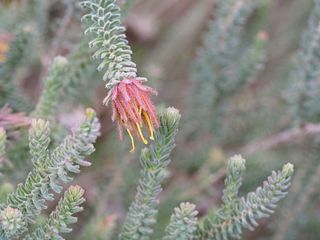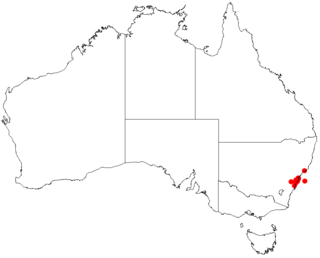
Darwinia, sometimes commonly known as mountain bells or simply bells, is a genus of about 70 species of evergreen shrubs in the family Myrtaceae, endemic to southeastern and southwestern Australia. The majority are native to southern Western Australia, but a few species occur in South Australia, New South Wales and Victoria. The genus was named in honour of Erasmus Darwin, grandfather of Charles Darwin by Edward Rudge in 1816. Most darwinias grow to a height of between 0.2 and 3 m, and many are prostrate shrubs. Most have small, simple leaves and the flowers are often grouped together, each flower with five red, white or greenish petals and ten stamens. In many species, the flowers are surrounded by large, colourful bracts, giving rise to their common names.

Banksia ericifolia, the heath-leaved banksia, or lantern banksia, is a species of woody shrub of the family Proteaceae native to Australia. It grows in two separate regions of Central and Northern New South Wales east of the Great Dividing Range. Well known for its orange or red autumn inflorescences, which contrast with its green fine-leaved heath-like foliage, it is a medium to large shrub that can reach 6 m (20 ft) high and wide, though is usually half that size. In exposed heathlands and coastal areas, it is more often 1–2 m (3.3–6.6 ft).

Banksia paludosa, commonly known as the marsh or swamp banksia, is a species of shrub in the plant genus Banksia. It is native to New South Wales, Australia, where it is found between Sydney and Batemans Bay, with an isolated population further south around Eden. There are two recognised subspecies, the nominate of which is a spreading shrub to 1.5 m (4.9 ft) in height, and subsp. astrolux is a taller shrub to 5 m (16 ft) high found only in Nattai National Park.

Grevillea mucronulata, also known as green spider flower or green grevillea, is a species of flowering plant of the family Proteaceae andt is endemic to New South Wales in Australia. Described by Robert Brown in 1810, it is found in open sclerophyll forest or woodland around the Sydney region and New South Wales south coast. It grows as a small bush to 3 m (9.8 ft) high and wide, with variable foliage and greenish flowers that appear over the cooler months from May to October. The flowers are attractive to birds.

Grevillea curviloba is a species of flowering plant in the family Proteaceae and is endemic to the south-west of Western Australia. It is a prostrate to erect shrub with short branchlets, divided leaves with linear to narrowly lance-shaped lobes with the narrower end towards the base, and white to cream-coloured flowers.

Hakea teretifolia, commonly known as the dagger hakea, is a species of woody shrub of the family Proteaceae and is common on heathlands in coastal eastern Australia from northern New South Wales through to Victoria and Tasmania. A very prickly shrub, it is rarely cultivated but easy to grow.

Grevillea linearifolia, commonly known as linear-leaf grevillea, is a species of flowering plant in the family Proteaceae and is endemic to New South Wales. It is an open, erect shrub with linear to narrowly elliptic leaves, and clusters of white flowers.

Grevillea manglesii is a species of flowering plant in the family Proteaceae and is endemic to an area around Perth in Western Australia. It is a spreading shrub with divided leaves, with triangular or linear lobes, and clusters of cream-coloured or white flowers.

Lambertia formosa, commonly known as mountain devil, is a shrub of the family Proteaceae, endemic to New South Wales, Australia. First described in 1798 by English botanist James Edward Smith, it is the type species of the small genus Lambertia. It is generally found in heathland or open forest, growing in sandstone-based soils. It grows as a multistemmed shrub to around 2 m (7 ft) with a woody base known as a lignotuber, from which it regrows after bushfire. It has stiff narrow leaves, and the pink to red flowerheads, made up of seven individual tubular flowers, generally appear in spring and summer. It gains its common name from the horned woody follicles, which were used to make small devil-figures.

Darwinia glaucophylla is a plant in the myrtle family Myrtaceae which grows as a prostrate shrub, sometimes forming extensive mats. It has bluish green leaves and white flowers in small groups which fade to reddish pink as they age. It is only known from about fifteen sites in the Gosford area and is listed as "threatened" in New South Wales legislation.

Baeckea brevifolia is a species of flowering plant in the family Myrtaceae and is endemic to south-eastern New South Wales. It is a shrub with narrow egg-shaped to oblong leaves and white to pink flowers with nine to fifteen stamens.

Darwinia grandiflora is a flowering plant in the family Myrtaceae. It is a dense, mat forming, prostrate shrub with clusters of tubular red flowers and is endemic to New South Wales.

Lambertia orbifolia, commonly known as the roundleaf honeysuckle, is a shrub or small tree that is endemic to the south-west of Western Australia. It has more or less circular leaves and groups of between four and six orange-red flowers.

Darwinia oxylepis, commonly known as Gillham's bell, is a plant in the myrtle family Myrtaceae. It grows as a dense, upright shrub 1.0–1.5 m (3.3–4.9 ft) high, and produces large numbers of red inflorescences prominently displayed on the ends of the branchlets in spring. It is one of a group of Darwinias including D. leiostyla, D. macrostegia, D. meeboldii, D. collina and D. squarrosa collectively known as mountain bells. The species is found in only a few seasonally moist gullies near the lower slopes of the Stirling Range National Park and nearby Porongurup National Park and is therefore classified as endangered.

Pultenaea stipularis, commonly known as handsome bush-pea, is a species of flowering plant in the family Fabaceae and is endemic to New South Wales. It is an erect shrub with glabrous stems, linear to narrow elliptic leaves, and yellow to orange flowers, sometimes with red markings.

Darwinia apiculata, commonly known as the scarp darwinia, is a plant in the myrtle family Myrtaceae and is endemic to a small area in Western Australia. It is a rounded, densely branched, small shrub with thin red branches and scattered small leaves. The flowers are arranged in small groups on the ends of the branches, their most obvious feature being long, red, pointed bracts surrounding each flower and a longer red style with scattered hairs near its tip.

Darwinia chapmaniana, commonly known as Chapman's bell or Eganu bell, is a plant in the myrtle family Myrtaceae, and is endemic to the south-west of Western Australia. It is a low, rounded, spreading shrub with greyish, hairy leaves and flowers in heads of about 14 small, tubular flowers. The heads are surrounded by long, reddish-yellow, hairy bracts.

Darwinia diminuta is a plant in the myrtle family Myrtaceae and is endemic to New South Wales. A small spreading shrub with white to pinkish tubular flowers arranged in pairs, with a restricted distribution mostly in the Sydney region.
Hibbertia echiifolia is a species of flowering plant in the family Dilleniaceae and is endemic to northern Australia. It is a variable shrub with elliptic to lance-shaped or oblong leaves and yellow flowers arranged singly in leaf axils, with twenty-nine to forty-five stamens arranged around the three carpels.

Daviesia intricata is a species of flowering plant in the family Fabaceae and is endemic to the south-west of Western Australia. It is a glabrous shrub with densely tangled branches, sharply-pointed, needle-shaped or flattened phyllodes and apricot-yellow and dark red flowers.




















